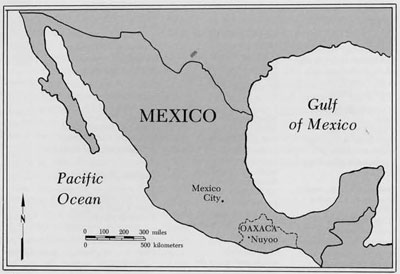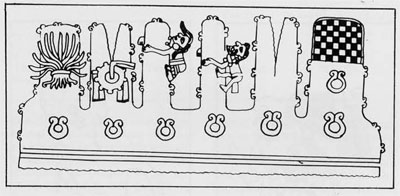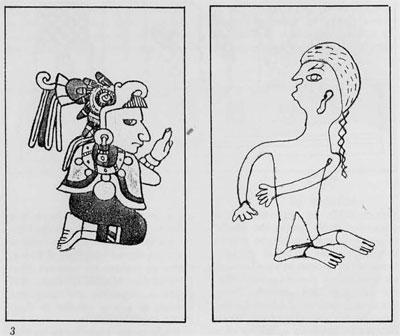- A contemporary Mixtec drawing of a line of hills .
- The koo savi by Fernando perez Sarabia. The caption reads: “The serpent of the rain, in the air, looking for a place to live”.
- The place sign of Coixtlahuaca from the Codex Ixtlan, which is a copy fo the Post-conquest Lienzo of Coixtlahuaca
- The koo savi by Juan Lopez nunez. Note the seeds on its skin.

The Mixteca region of the Mexican states of Oaxaca, Puebla, and Guerrero is the home of one of the largest Native American groups in southern Mesoamerica (Fig. 1). Over 250,000 Mixtec speakers live in the dozens of small communities scattered throughout the high, dry lands of the Mixteca Baja, the cool forested mountains of the Mixteca Alta, and the steamy tropical plains of the Mixteca de la Costa. In addition to the quarter of a million Mixtecs in the homeland, an equal number inhabit the urban sprawl of Mexico City and farm labor camps in the United States, as grinding poverty, soil erosion, and other factors have forced many thousands to migrate. I had the privilege of living in one Mixtec community, Santiago Nuyoo (pronounced New-yo), a town of about 2500 persons straddling the mountainous Alta and the tropical Costa. There I met the storytellers Fausto Modesto Velasco, Guadalupe Rojas, and the late Lorenzo Rojas, as well as my good friends Marcial Perez, Indalecio Velasquez, Fernando Perez Sarabia, and Juan Lopez Nunez. This article is based on the stories, ideas, and drawings they have shared with me, and could never have been written without them.
Besides its large indigenous population and the diversity of its climates, the Mixteca is also known as the home of one of the most exceptional traditions of manuscript illumination to be developed in the New World. Over the centuries prior to the arrival of the Spanish, Mixtec scribes produced a distinctive corpus of screenf old “picture books,” or codices, which greatly influenced other Mesoamerican writing styles. Several of these codices have been preserved, and tell us of the gods the Mixtec worshipped, the ceremonies the Mixtec celebrated, the royal pedigrees of their rulers, and the deeds of their heroes. The surviving codices are unique in Mesoamerica, since they complement one another in the information they contain, and several of them are among the few manuscripts from the New World that actually predate the conquest. This means that unlike native documents produced after the conquest, they come down to us unmediated by Spanish colonial influence, an influence that, in the course of seventy to eighty years, erased this exceptional tradition of writing and manuscript illumination.
Even though the unique value of the codices has long been appreciated, the lack of any kind of auxiliary text explaining the content of the Mixtec pictorials (such as the Rosetta Stone or Bishop Landa’s account of Maya hieroglyphs) has made the process of decipherment extremely difficult line of bills depicted in the Codex Vienna, and in Figure 3, which shows a woman sitting in Nuyoo and one sitting in the Codex Nuttal, the similarities in pictorial conventions are sometimes striking. This suggests that there is a cultural, perceptual element in Mixtec manuscript painting, an element which continues to persist even after the deaths of the last of the Mixtec princely scribes.
Here I use some of the drawings made by Fernando Perez Sarabia and Juan Lopez Nunez, along with the accounts of Fausto Modesto Velasco and other men and women in Nuyoo, to examine a figure which is frequently portrayed in the codices, the feathered serpent. The feathered serpent, best known perhaps for its association with the Central Mexican god Quetzacoatl, can be found in the art of all the high cultures of Mesoamerica, from the earliest examples of the Olmec to the last manuscripts produced in the native style during the colonial period (Fig. 5). Even though the feathered serpent has fired the artistic imagination of Mesoamerica for centuries, we know very little about this mysterious creature, called the koo savi (pronounced coh saw-we), or “serpent of the rain” in Nuyoo. Nuyootecos have many important observations to make about the koo savi, which will help us to understand both the nature of this creature, and why it is represented in the ways it is.
The Feathered Serpent

When people in Nuyoo describe the feathered serpent, they often emphasize its large size, with estimates of its length ranging from six to twenty meters. Drawings of the koo savi (Figs. 4,6) demonstrate that there is variation in its form. Some people see it as cigar-shaped, like a giant earthworm, while others regard it as more reptilian. As is true for the ancient Aztecs, Maya, and other peoples of Mesa-america, the koo savi is feathered (koo tumE). It has luminous, multicolored plumes which people compare to the feathers of a rooster’s tail. The plumes are depicted as sprouting from the head of the koo savi (Fig. 4), as often is the case in Precolumbian art, or from a winglike structure on its side (Fig. 6). Nuyootecos also say that the koo savi has a shiny skin, which glimmers, as one man put it, “like a pool of water when the light strikes it.”
Many people in Nuyoo have seen feathered serpents, some when they pass above, flying through the air, while others have caught a glimpse of one when it suddenly emerged from a pond or marsh. When a kook savi flies, it is surrounded by rain clouds, which it is said to bear on its back. It thus always moves in the midst of a storm. In fact, it is in stormy weather that people say they have seen them. Tata Fausto tells of the time a koo savi flew over him when he was out weeding a cornfield on the side of a hill. It had been a clear day, but as the koo savi drew near, the sky began to darken, and rain fell. By the time the koo savi was overhead, the cornfield was lashed by a violent rainstorm. Tata Fausto had just enough time to pull a reed mat over himself and crouch under it. As he struggled to keep the mat from blowing away, he peeked out and saw the koo savi go by, wriggling like a fish. Once the koo savi cleared the top of the hill, the rain diminished and the sky began to lighten. Within moments the storm ended, the clouds disappeared, and the sun shone. As Tata Fausto’s experience suggests, the koo savi is associated with violent and destructive storms. People can point out the area in Nuyoo where a koo sari once demolished a house that lay in its path, and many emphasize the danger of its thrashing tail which may knock down trees and cause landslides. It is important to realize that the koo savi is not a god for Nuyootecos. The saints in the church and other obviously Prehispanic deities such as the nu’un savi (rain god) are considered to be diosi, or divinities, but not the koo savi. Nor do people make prayers and sacrifice to the koo savi for rain, as they do for the saints and nu’un savi. It is rather a kiti, or animal, and as much a part of the local fauna as an opossum or deer. It is rare, like a puma, but an animal nonetheless. Many consider it a kitsi la’vi, or “a humble animal,” in that it does not generally cause problems for people. Some say, however, that it will gobble up sheep, goats and cattle that stray near the place where it lives.
While the koo savi is not considered to be a god, it is said to be EE or “delicate,” an adjective often used to describe the saints and other deities, but also things which are fragile and easily damaged. The koo savi is EE not only because it is an animal which is especially beneficial to humans, but also because harming it invites disaster. One story tells of several hunters who killed a koo savi in neighboring Santa Lucia Monteverde. After it died, the surrounding trees, shrubs, and grasses began to dry up and die. To this day the spot is barren and lifeless, and some say that no rain ever falls there. The important and fragile link the koo savi sustains with the surrounding flora makes many people consider the killing of a koo savi a great wrong, as Nuyootecos are farmers and their lives depend on the fertility of their crops. This attitude can be seen in another story told about the koo savi, in which it landed on the roof of the house of a man in the Mixtec town of Chalcatongo. As the story goes, the weight of the animal threatened to crush the house, so the owner tried to scare it away. The koo saoi would not budge, so the man went inside and took out his rifle and shot it. The animal fell off the roof and died of its wounds. Soon after, a nearby pond dried up, and it stopped raining in the area. The corn, beans, and squash which the people of Chalcatongo had sown began to die, and the harvest was lost. Everyone blamed the man who had shot the koo savi for this misfortune, and they became so upset that they dragged him out of his house one day and lynched him.

The close connection between the koo savi and plant life can also be seen in the drawings, as the authors explained that the seeds of various plants, such as corn, wheat, coffee, beans, and squash, can be found on the skin of the koo savi, “as if they were painted there” others say that the koo savi has a small pouch on its underside, like a marsupial, and there it stores the plant seeds). The way these seeds are represented, as a number of dots on the animal’s skin (Fig. 4), may explain similar markings sometimes found on feathered serpents depicted in Precolumbian art.
In addition to its connection with plant fertility, the koo savi is also associated with the beginning of the rainy season. The feathered serpent begins to fly in the months of May and June “to cause the clouds to rise,” so that the rain may fall. As in tropical environments the world over, the Nuyoo area is subject to a long and thorough dry season, followed by an intense wet season. The dry season runs from late September through the beginning of May, and the wet season in mid-May until mid-September. The seasonality of precipitation is reflected in the vegetation. After the rain ends in September, the luxuriant growth in the region begins to dry out, and by January, what was once a lush, verdant valley is brown and parched. Wild animals that had fed on the harvest grow thin, it is difficult to find sufficient fodder for domestic animals, and the area is plagued by forest fires. All of this is suddenly reversed in May, when the rains begin again. In the space of a week or two, the valley sides turn green, animals begin to put on weight, and, most importantly for Nuyootecos, the corn sown in April begins to sprout. A few days of rain thus bring about a dramatic change in Nuyooteco surroundings, partly because of the koo savi. Its flight ushers in the rainy season, and becomes an expression of vibrant, fertile life. Its behavior and its symbolism make the koo savi a representation of those processes which make the natural world fecund.
While they can most frequently be seen in the months of May and June, the koo savi can also be observed when they wish to make a new home. The koo saoE lives in marshes, ponds, and lakes. Thus, when it looks for a new home, it flies to a suitable site, stations itself over the spot, and allows the rain which it carries to inundate the area, forming another marsh or pond. Then it plunges in, and the storm ends. The area around its new home then bursts with fertility. Flowers bloom, crops begin to bear fruit, and other plants and shrubs grow lush. Meanwhile the old home of the koo savi slowly dries up, as it is no longer there to replenish the moisture. The whole process may take several days, and there are many stories of people like the man from Chalcatongo who had the misfortune to live close by the site a koo savi had selected for its home. In some of these accounts, the people managed to drive the animal away before it flooded them out. In others, the people were not so lucky, and had to move away. One man told me how a koo savt once tried to make its house on a hilltop overlooking Mexico City. The government was forced to take action, since the rain that fell was flooding many homes. Helicopters were sent, and they managed to frighten the animal away before it caused major damage According to Nuyootecos, a koo savi once lived in a pool below a large waterfall to the northeast of the town center. This pool was important because it was there that people would take newly born infants to be “baptized” so that they would become shamans (tee nuvi). The children were placed in a wooden box, and set out in the swirling waters of the pool. If the mist rising from the water had a reddish tint, “like the light of the setting sun,” then the child would die. If the mist appeared white, then the child would live, and grow to be a powerful shaman. While the child was floating in the pool, the koo savi would emerge and swim over to the box. It would then “bathe” the child by licking it with its tongue. This would give the future shaman a special relationship with the rain which he would be able to summon through prayers and sacrifices.
The place of the koo savi in Nuyooteco sexual symbolism should be mentioned. The koo savi, since it is a koo, or snake, has a phallic association. In fact, the effect the koo savi has on plant growth is compared to that which males have on females when they engage in the sexual act, as the earth is considered to form the “womb” of a developing seed (a wet, germinating seed is compared to a pregnant woman), and rain which is carried by the koo savi functions much like semen in generating growth. This same theme can be seen in the association of the koo savi with birds. The koo savi is bird-like because it flies through the air and has beautiful feathers
(which Nuyootecos compare to the tail feathers of a rooster, an animal widely viewed in Mexico as the epitome of male virility). Birds are considered to be the purest and most beautiful of animals, which corresponds to Nuyooteco valuation of male sexuality. The sky, the domain of the birds, is also a distinctly male arena. The deities which are associated with the sky, such as the nu’un savi, carry symbols of masculinity, such as a machete and ax. In short, the koo saoi, linked with the birds, the sky, and life-generating rain, is an expression of the processes which make the natural world fertile, and as such is a sexually charged figure, intimately connected with the male role in procreation.
Conclusion
A longstanding tradition in Mesoamerican anthropology, dating at least to the time of Alfred Tozzer and The University Museum’s own Daniel Brinton, has been the use of the observations of the Indian peoples of Mexico and Guatemala to aid in the interpretation of Pre-columbian texts. As the discussion of the Nuyooteco koo saoi indicates, contemporary Mixtec folklore and classification can expand our understanding of Preconquest Mixtec mythology and symbolism preserved in the codices. Talking to people like Tata Fausto Modesto Velasco affords us an insight into the connection the feathered serpent has with rain, plant fertility, the changing landscape in a tectonically active region, and ideas about gender.
Beyond aiding in the interpretation of the content of Pre-cololumbian texts, the material presented here shows us that contemporary Mixtec peoples can help us address stylistic questions about ancient manuscripts. As the drawings reproduced illustrate, many of the stylistic elements found in the codices occur in Nuyooteco drawings, despite the fact that the contemporary authors are separated from their ancestors by at least 450 years. The remarkable similarity between the drawings made by Mixtec Indians today and those by their ancestors centuries ago can be attributed, in part, to the fact that what is represented has not changed greatly. Thus women continue to sit in the same way today as they did in Prehispanic times, on the floor with their legs folded under them and to one side.
There may, however, also be a much deeper, perceptual reason, a way of looking at the world that is fundamentally Mixtee. The similarities between the depictions of mountain chains by people in Nuyoo and the artists of the Codex Nuttal suggest that the Mixtec represent the physical world in a manner not necessarily inherent in the objects themselves, but instead based in the Mixtec experience of their environment, and perhaps in categories of relationships between objects which are rooted in Mixtec language and discourse. We need to identify more Mixtec artists such as Juan Lopez Nunez and Fernando Perez Sarabia who can help us explore ancient Mixtec canons of representation, just as contemporary speakers of Mixtec aid in understanding the morphology and phonology of the Mixtec spoken in the past, and contemporary story tellers assist in interpreting Pre-hispanic myths.




